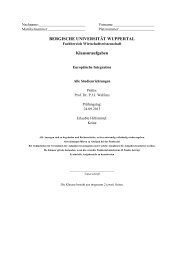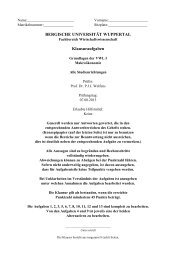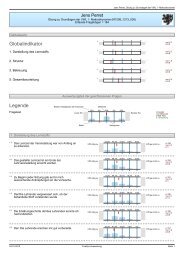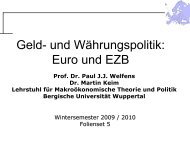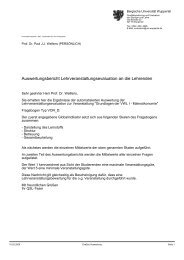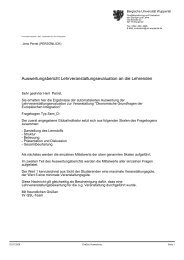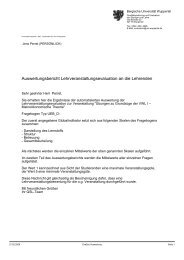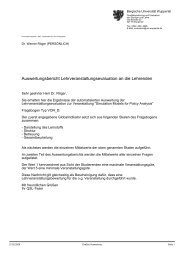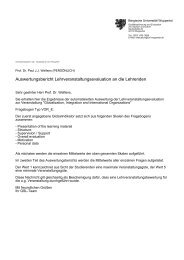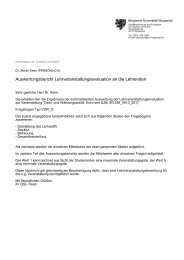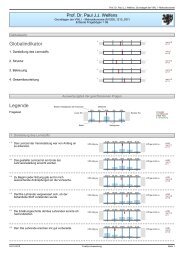UNIVERSITÄT POTSDAM - Prof. Dr. Paul JJ Welfens
UNIVERSITÄT POTSDAM - Prof. Dr. Paul JJ Welfens
UNIVERSITÄT POTSDAM - Prof. Dr. Paul JJ Welfens
You also want an ePaper? Increase the reach of your titles
YUMPU automatically turns print PDFs into web optimized ePapers that Google loves.
ing some further – more technical – assumptions, growth rates depend on innovation<br />
rates – that is, on the speed with which new technological knowledge is built up.<br />
Integrating two economies similar (or even identical) in terms of traditional endowments<br />
would lead to either unchanged trade patterns and growth rates or to increased<br />
specialization and higher growth rates in both countries. The dynamic properties<br />
of this model heavily depend on the characteristics of the stock of accumulated<br />
knowledge before integration. Because of similar endowments with traditional factors<br />
the only difference before globalization lies in the degree of knowledge specialization<br />
in different areas. Given that both economies are completely specialized on complementary<br />
fields of knowledge, integration will have no effects, neither on technological,<br />
production and trade patterns nor on long-run growth. Instead, if the stocks of knowledge<br />
have a certain overlap in both economies (e.g. knowledge accumulated in the<br />
same fields of science and technology) integration will weed out these “inefficiencies”.<br />
Each country specializes on one part of this knowledge available to both economies via<br />
full integration of markets. In this situation growth is higher in both countries compared<br />
with those in closed economies. To the extent that the Internet facilitates accumulation<br />
of knowledge and reduces international integration costs one may expect a growth bonus<br />
due to faster technological progress within a larger radius of integration. At the<br />
same time the rising adjustment speed in digital financial markets might contribute to<br />
more market volatility and hence transitorily or permanently reduced growth rates.<br />
Apart from new growth and new trade theory, evolutionary economics in a<br />
Schumpeterian tradition is concerned with the relationship between technology, trade<br />
and growth. Although it lacks a consistent body of formal modeling tools, evolutionary<br />
economics has provided a lot of interesting insights into the details of the working of<br />
economic systems. Evolutionary thinking is fundamentally based on the variationselection<br />
principle which allows one to look at the dynamic properties of systems and,<br />
thus, it is based on economic development. Basically, evolution is thought of as being<br />
generated by creating a variety of different products and processes. Selection processes<br />
(e.g. markets) then work on reducing this variety to a certain number of viable products.<br />
The diversity of evolutionary theorizing cannot be dealt with here (on this see<br />
DOSI / PAVITT / SOETE (1990), WITT (1993) or HODGSON (1993)). One of the<br />
main forces that generate new products or processes (and, thereby, increase variety) is<br />
innovation and technological change.<br />
Concentrating first on variation, empirical studies have found that higher rates<br />
of innovation lead to higher rates of economic growth (e.g. FAGERBERG (1988)). The<br />
larger the number of different products and the higher the rate of new product generation<br />
the higher the rate of long-run growth. Saviotti has worked out a conceptual and<br />
semi-formal tool to show that we are observing a constantly increasing number of different<br />
products. Higher degrees of product variety cause higher consumer utility. This<br />
is a main reason for economic growth (SAVIOTTI (1991)). This mechanism mainly<br />
29



